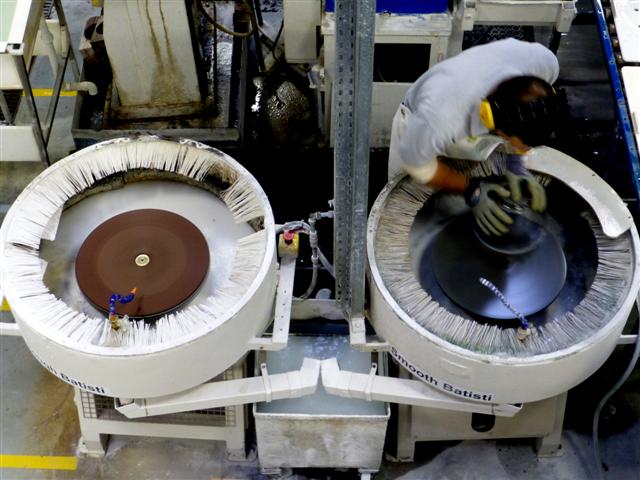グラスに酸化セリウムラテを「飲ませて」、よりクリアで明るい状態でスポットライトを浴びる準備をする方法。

CeO₂はガラス界の「研磨バリスタ」です。その粒子は単に研磨するだけでなく、ガラスとスラリーの界面においてシリカとの酸化還元反応およびイオン交換反応にも関与します。そのため、傷は柔らかくなり、ピークはせん断され、緻密で光学的に滑らかな表皮が残ります。そのため、CeO₂は多くのガラス用途で酸化鉄やジルコニアに取って代わり、透明性が重要な部品には今でも主力製品となっています。
回転式バレルタンブラーは、媒体と部品を制御された「地滑り」のように押し潰します。ガラスの場合、複雑な形状(ボトル、レンズ、装飾品など)でも均一で低応力の接触、高いバッチスループット、そして再現性を実現します(パラメータを適切に調整すれば)。 研磨 積極的なカットではなく。


| パラメータ | 推奨される出発点 | なぜそれが重要なのか |
|---|---|---|
| メディア | 磁器(研磨グレード)または軟質樹脂/円錐形状。最終パス用のオプションのフェルトインサート | 傷を最小限に抑え、スラリーを均一に運ぶ |
| メディア: 部品 | 3:1~5:1(体積比) | 部品同士の衝突を防ぎ、流れを安定させます |
| 充填レベル | バレル容量の45~55% | デッドゾーンのない安定した「雪崩」 |
| バレル速度 | 約20~35 RPM(サイズによって異なります) | 低速 = スムーズな動作; 速すぎるとエッジが傷つく可能性があります |
| スラリー | DI水中のCeO₂ 1~3重量%;pH 6.5~8.0 | 低傷性と化学的な補助のバランス。ガラスの安全性を確保する中性pH。 |
| 添加剤 | 少量の非イオン性湿潤剤/消泡剤 | カバー力を向上させ、空気の閉じ込めを防ぎます |
| ステージタイム | プレポリッシュ30~60分 → 仕上げ30~90分 | Ra/Rq降下とヘイズ測定による調整 |
| リンス | 徹底したDIすすぎ+中性洗剤 | 細かい粒子を除去して「引きずり跡」を防ぎます |
建築用ガラスや一般ガラスの場合、透明度を定量化する。 光透過率T vis 下 ISO 9050 (またはEN 410)。この試験を、目視によるヘイズや散乱光による検査と組み合わせます。精密光学部品の場合は、スクラッチディグ法または干渉法による粗さ(Rq)を追加することで、研磨された「表面」が単に明るくなるだけでなく、より滑らかになっていることを証明できます。
| 症状 | 考えられる原因 | 即時修正 |
|---|---|---|
| 霧はゆっくりと消える | CeO₂が薄すぎる;媒体が艶出しされている;速度が低すぎる | CeO₂を2~3重量%に上げる;培地をコンディショニング/リフレッシュ;+3~5 RPM |
| ランダムな細かい傷 | 汚染物質、角質媒体、pHドリフト | スラリーを濾過し、バレルをすすぎ、磁器/フェルトに切り替え、pHを約7に保つ |
| エッジの傷み/欠け | バレルの回転速度が速すぎる、メディアと部品の比率が低すぎる | RPMを下げ、メディア比率を3:1以上に上げる |
| 乾燥後の乳白色の膜 | 残留微粒子または硬水塩 | DIリンスを改善し、最終的なイソプロパノール置換リンスを追加します。 |
私たちの 回転バレルバイブレーター 安定したメカニズムを提供しながら 仕上げ剤 (セリウム配合物を含む)が化学反応を起こします。これらを組み合わせることで、微細な粗面ガラスを、再現性の高い生産グレードの効率で高透明度の表面へと変換します。
Eメール : info@surface-polish.com